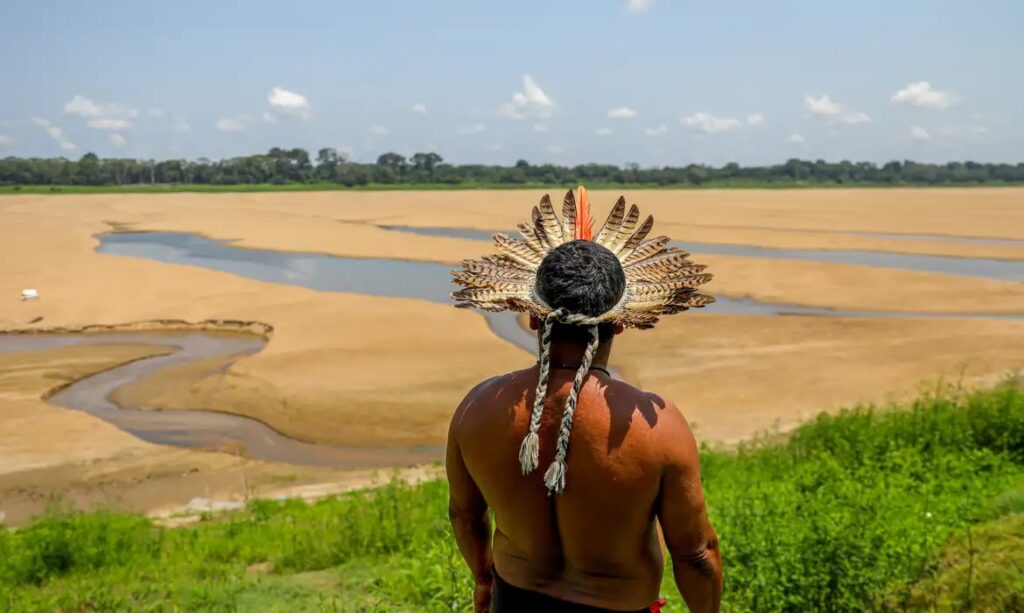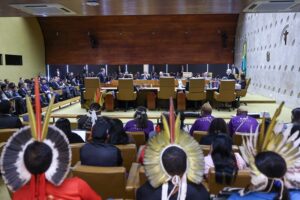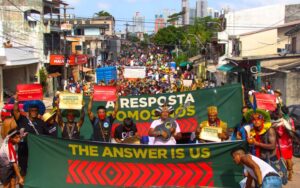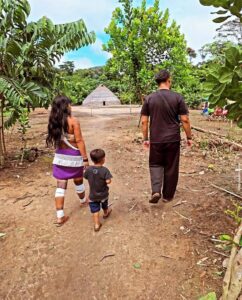Coiab data highlights the unprecedented severity of the river drought and reports of hunger and difficulties with healthcare access in many regions in the biome
Supported by data on the unprecedented severity of the drought and the uncontrolled spread of hotspots in the Amazon, the Observatory for the Human Rights of Isolated and Recently Contacted Indigenous Peoples (Opi) has sent letters to the Ministry of Justice (MJ), the Ministry of Indigenous Peoples (MPI), the Federal Prosecution Office (MPF), the National Foundation for Indigenous Peoples (FUNAI) and the Special Secretariat for Indigenous Health (SESAI) asking what measures are being planned to mitigate the effects on indigenous lands in the region.
Opi asked authorities what measures are being taken to: ensure the delivery of food to communities in situation of food insecurity; provide access to drinking water in regions where the drought is causing extreme or severe shortages; support indigenous fire fighting brigades; guarantee healthcare in villages isolated by drought and fire; monitor the access to water and food of isolated indigenous peoples who by their very condition are more vulnerable to the adverse effects of intense climate change in the Amazon biome; and finally, ensure the preparation of contingency plans for situations such as the current one, in view of the obvious worsening of the climate emergency and its direct effects on indigenous territories in the Amazon.
In a study launched in September, the Coordination of Indigenous Organisations of the Brazilian Amazon (COIAB) made the world aware of the seriousness of the drought. According to the study, 149 lands are suffering extreme or severe drought. Forty-two of which are in extreme conditions, which means water scarcity, absolute drying up of rivers, loss of crops, pastures and forests. The area of these territories in severe drought corresponds to 53% of all indigenous areas in the region.
Another study, launched by Coiab and Opi during COP 16 in Cali, Colombia, analysed data on the uncontrolled fires that have also affected several indigenous territories in the region, including those with isolated groups. Although the data for the current year is partial (up to September), 2024 has already broken the record of the historical series by 3,918 outbreaks. Compared to the second worst year, 2020 (with 5,187 outbreaks), 2024 had 75.5% more outbreaks, which points to a continued worsening of environmental pressures and possibly a combination of climatic factors and human actions.
In the letter, Opi reports on a series of calls for help that have come in from various regions of the biome since July, when the weather conditions began to worsen. Entire villages have become food insecure due to the loss of crops to fire, the impossibility of fishing or the difficulty of accessing the surrounding towns to buy food.
Two of the communities affected by the humanitarian emergency, the Oro Win and Cabixi peoples, in the region where the Pacaás Novos River enters the Uru-Eu-Wau-Wau Indigenous Land, have been asking for help since September, when the river reached levels they had never seen before. The drought prevented travel between communities and made fishing difficult.
In Mato Grosso, in the Capoto/Jarina Indigenous Land, on September 1st, a huge fire hit the Kajkwakhratxi (Tapayuna) gardens, destroying all the community's crops. What followed was a scenario of absolute destruction, with thick smoke hanging over the Kawêrêtxikô village for over a month, almost all of the 214 residents suffering from some kind of respiratory illness, children and the elderly having to be rushed to the city, a lack of medicines and a situation of extremely serious food insecurity in the community. Faced with such urgency, Opi joined other civil society organisations that are partners of the Kajkwakhratxi in creating an emergency campaign to buy food supplies.
In the Vale do Javari Indigenous Land, which is home to the largest number of isolated indigenous groups in the world, the drought has isolated 74 villages and made it impossible to travel by river, which resulted in an increase in the price of basic supplies, causing food insecurity and difficulties in accessing healthcare. In a statement, the Union of Indigenous Peoples of the Javari Valley (Univaja) asked for government support in providing larger aircraft to allow for the rotation of health teams serving the territory and the delivery of medicines and supplies.
In the Mamoadate Indigenous Land in Acre, on the border between Brazil and Peru, the combination of drought and smoke from the fires has been affecting indigenous peoples' health and is directly impacting the isolated Mashco-Piro who move seasonally between the two countries. In September, midwife and healer Maria Artur Manchineri died in the city of Assis Brasil and the Sesai helicopter allocated to take her body to her home village of Extrema for their funeral rites, was unable to take off because of the smoke from the forest fires. Rescuing the sick is practically impossible due to the climate emergency and the frightening increase in the number of fires.




